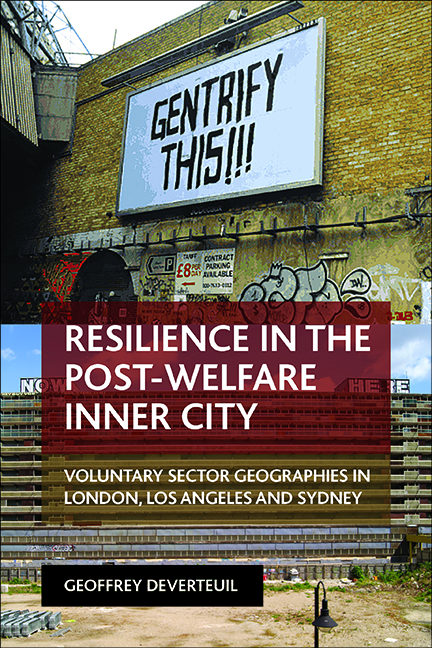 Resilience in the Post-Welfare Inner City
Resilience in the Post-Welfare Inner City Book contents
- Frontmatter
- Dedication
- Contents
- List of tables and figures
- About the author
- Acknowledgements
- Preface
- Part One Introducing resilience in the post-welfare inner city: conceptual and methodological considerations
- Part Two Case studies: spatial and social resilience in London, Los Angeles and Sydney
- Part Three Conclusions, critical resilience, commons and austerity
- References
- Index
seven - Mixed place-types
Published online by Cambridge University Press: 10 March 2022
- Frontmatter
- Dedication
- Contents
- List of tables and figures
- About the author
- Acknowledgements
- Preface
- Part One Introducing resilience in the post-welfare inner city: conceptual and methodological considerations
- Part Two Case studies: spatial and social resilience in London, Los Angeles and Sydney
- Part Three Conclusions, critical resilience, commons and austerity
- References
- Index
Summary
Here I consider matters of service hub resilience within the four areas with mixed levels of gentrification and upgrading: the London boroughs of Islington, Lambeth and Southwark, and the Darlinghurst/Kings Cross area in Sydney. All featured medium gentrification index scores, medium levels of voluntary-sector organisations per capita, medium levels of minority populations, and medium criminalisation index scores. In particular, I found that gentrification was more mixed than in the ‘established gentrified’ neighbourhoods, creating hodgepodge geographies of resilience and displacement, with gentrification counterposed with, and sometimes threatening, conspicuous areas of poverty and, in the case of London, large-scale council estates. This was epitomised by the ‘super-gentrification’ found in Barnsbury in Islington (Butler & Lees, 2006), set within one of the five poorest boroughs in London (MacInnes et al, 2011). Islington was not alone – both Lambeth and Southwark scored in the top third of London boroughs in terms of unemployment, households on benefits and in poor health, alongside significant (and growing) pockets of gentrification and wealth. In Darlinghurst/Kings Cross in Sydney, significant gentrification co-habited with extremes of substance abuse, prostitution and homelessness, attracted to and anchored by Sydney's traditional red-light and drugs district.
The mixed nature of these areas is partly an outcome of recent and very targeted redevelopment policies, with new-build gentrification punctuating the 19th-century and early 20th-century built environment in both London and Sydney. For instance, in Lambeth and Southwark there is now considerable new-build gentrification along the River Thames. Fainstein (2010: 126) chronicled the redevelopment of the South Bank, particularly the Coin Street and Oxo Tower project, of how ‘by the mid-1990s, the South Bank was the site of a host of new projects and improvement schemes involving the public and private sectors, separately and together, and Coin Street had been redefined as both a model development and a catalyst for wider change’. Indeed, by 2014, most of the South Bank was experiencing significant new-build gentrification, spilling over from neighbouring Southwark (see case study). But along the main line from Waterloo Station to Weymouth lay several unbroken miles of council estates (Hamnett, 2003) that buffer the gentrifying zones of the riverside new builds (Davidson & Lees, 2005; Watt, 2013), including Vauxhall, pictured in Figure 7.1.
The gentrifier proxy population living along the Thames riverside of Lambeth grew by 94% between 1991 and 2001, while for Southwark it was 208% (Davidson & Lees, 2005).
- Type
- Chapter
- Information
- Resilience in the Post-Welfare Inner CityVoluntary Sector Geographies in London, Los Angeles and Sydney, pp. 121 - 148Publisher: Bristol University PressPrint publication year: 2015


